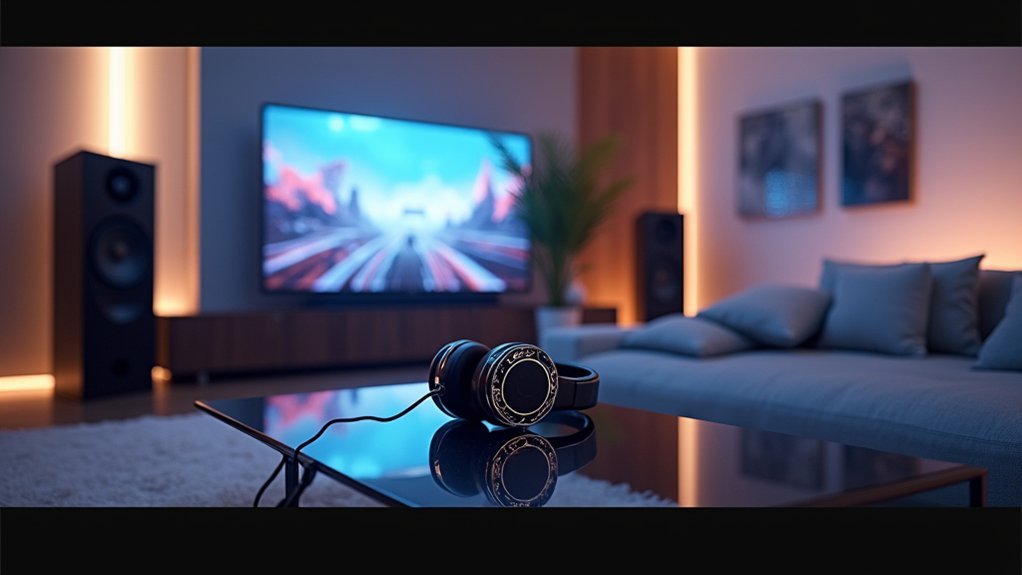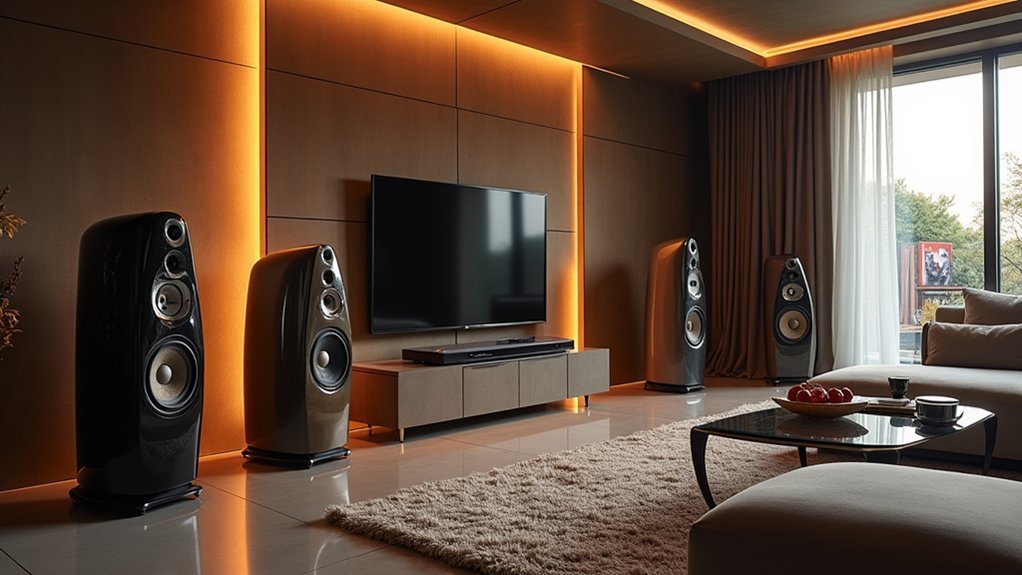You’ll find exceptional positional audio through Sony’s 360 Reality Audio technology, which creates spherical soundfields, and Dolby Atmos systems that treat sounds as movable objects in 3D space. Creative’s Sound Blaster series offers gaming-focused processing, while binaural audio solutions mimic natural ear perception. Multi-driver headphones like Roccat Kave provide dedicated channels, object-based platforms enable dynamic movement, and head-tracked systems adjust audio based on your position. These seven technologies reveal tactical advantages and cinematic experiences beyond traditional stereo sound.
Sony 360 Reality Audio Technology

When you’re seeking an audio experience that places you directly in the center of your music, Sony’s 360 Reality Audio Technology delivers precisely that through its object-based spatial sound system. This immersive audio technology creates a three-dimensional spherical field around you, positioning individual vocals and instruments from various directions to mimic real-world sound propagation.
You’ll access 360 Reality Audio content through streaming services like Amazon Music Unlimited and nugs.net, expanding your library of spatial audio tracks.
The ecosystem includes the 360 WalkMix Creator™ tool, which transforms stereo mixes into immersive experiences by precisely placing sound stems in diverse spatial locations.
Whether you’re a professional creator or music enthusiast, this technology enhances engagement across music listening and gaming platforms.
Creative Sound Blaster Series for Gaming
If you’re seeking exceptional positional audio for gaming, Creative’s Sound Blaster series delivers professional-grade sound processing that’ll transform your gaming experience.
You’ll find powerful models like the Sound Blaster Z and X-Fi Titanium HD, each engineered with advanced technologies that provide precise sound localization and immersive audio environments.
The series features SBX Pro Studio surround technology that creates virtual 3D soundscapes, allowing you to pinpoint enemy movements and environmental cues with remarkable accuracy.
SBX Surround Technology
Creative’s SBX Surround technology transforms your gaming audio experience by creating precise 3D soundscapes that let you pinpoint enemy footsteps, gunfire direction, and environmental cues with remarkable accuracy.
This virtual surround sound processing uses advanced algorithms to generate an immersive sound field that enhances your situational awareness during gameplay.
You’ll benefit from SBX’s automatic optimization across various headphones and speaker configurations, ensuring consistent performance regardless of your setup.
The technology supports multiple audio formats, including 5.1 and 7.1 surround sound, delivering rich soundscapes that bring games to life.
Creative’s customizable software suite lets you fine-tune audio settings to match your preferences, giving you complete control over your immersive sound environment for competitive gaming advantages.
Sound Card Models
The Sound Blaster Z stands as Creative’s flagship gaming audio solution, delivering exceptional audio processing power that maximizes the potential of SBX Surround technology.
You’ll experience superior sound quality that transforms your gaming sessions into immersive adventures with crystal-clear positional audio. The Z model excels at processing complex Audio streaming data, ensuring you hear every footstep and environmental cue with pinpoint accuracy.
While the X-Fi Elite Pro offers high-quality output, you might encounter positional audio limitations that affect competitive gaming performance.
The X-Fi Titanium HD features CMSS 3D technology for enhanced spatial awareness, but it’s weaker than SBX Surround for modern titles.
You’ll find discrete Sound Blaster cards outperform USB headsets notably, providing customizable settings and superior audio fidelity that elevates your entire gaming experience.
Dolby Atmos Spatial Audio Systems

You’ll find Dolby Atmos revolutionizes positional audio by treating sounds as movable objects in three-dimensional space rather than locking them to specific channels.
This object-based approach gives you pinpoint accuracy in games, letting you detect enemy footsteps above, below, or around you with remarkable precision.
Whether you’re using dedicated speaker arrays, Atmos-enabled soundbars, or compatible headphones, the system adapts to your hardware setup while maintaining that essential spatial awareness competitive gaming demands.
Object-Based Audio Technology
Revolutionary object-based audio technology transforms how you experience sound by treating individual audio elements as movable objects within three-dimensional space rather than confining them to traditional channels.
This approach creates immersive music and surround audio that places sounds above, around, and beside you with pinpoint accuracy.
Dolby Atmos exemplifies this technology’s potential, supporting up to 128 audio tracks and 64 unique speaker feeds for complex soundscapes.
You’ll hear footsteps moving overhead, rain falling from above, and dialogue positioned precisely where actors stand on screen. This enhanced positional awareness dramatically improves gaming experiences and film watching.
The technology works across various devices, from soundbars to headphones, making it accessible regardless of your setup.
Major streaming platforms now offer Dolby Atmos content, bringing cinematic audio directly to your living room.
Gaming Implementation Benefits
Three key advantages make Dolby Atmos spatial audio systems essential for serious gamers seeking competitive edges and deeper immersion.
First, you’ll gain superior situational awareness through precise directional audio cues that pinpoint enemy locations and environmental threats. This gaming advantage translates directly into improved performance during competitive matches.
Second, you’ll experience richer storytelling through advanced soundscapes that developers create using object-based technology. Sound elements move naturally through 3D space, making immersive worlds feel genuinely alive around you.
Third, you’ll enjoy versatile compatibility across gaming setups. Whether you’re using headphones or home theater systems, Dolby Atmos maintains consistent audio quality while adapting to your specific environment’s acoustics.
This optimization guarantees you never compromise on sound fidelity regardless of your gaming configuration.
Hardware Compatibility Requirements
Before diving into Dolby Atmos spatial audio, you must verify that your hardware compatibility meets specific compatibility requirements to access the technology’s full potential.
You’ll need a compatible audio receiver or soundbar with proper HDMI inputs for signal transmission. A minimum 5.1.2 speaker setup provides ideal immersive sound, featuring five main speakers, one subwoofer, and two overhead speakers for three-dimensional audio environments.
For headphones users, your devices must support Dolby Atmos Headphones technology, which simulates surround sound through stereo headphones via compatible software.
Gaming consoles like Xbox Series X and PlayStation 5 offer native support when connected to compatible systems.
Popular streaming services including Netflix, Amazon Prime Video, and Disney+ provide Dolby Atmos content, but you’ll need compatible playback devices for proper functionality.
Binaural Audio Processing Solutions

When you’re seeking the most natural and immersive audio experience, binaural audio processing stands out as the gold standard for recreating how your ears naturally perceive sound in three-dimensional space.
Binaural audio processing delivers the gold standard for natural, three-dimensional sound that mirrors your ears’ authentic spatial perception.
This technology uses two microphones to capture audio exactly as your ears would hear it, delivering exceptional 3D audio that enhances spatial awareness in gaming and virtual reality environments.
Binaural processing creates realistic soundscapes through several key features:
- HRTF customization – Tailors audio delivery based on your unique ear shape and head position
- Headphone optimization – Designed specifically for precise sound localization through headphones
- Gaming enhancement – Enables accurate directional audio for competitive advantages
- Cross-media compatibility – Works effectively in games, films, and VR applications for emotionally engaging experiences
Multi-Driver Surround Sound Headphones
Multiple dedicated drivers in each ear cup transform multi-driver surround sound headphones into powerful positional audio systems that deliver true multichannel experiences.
You’ll find models like the Roccat Kave 5.1 XTD create distinct audio channels through separate drivers, letting you pinpoint exact directions of in-game sounds. The Razer Tiamat 7.1 takes this further with additional drivers for thorough coverage, though durability might be compromised.
Your audio experience depends on compatible sound cards or processing software to access full multichannel potential.
These headphones excel in competitive gaming scenarios where accurate positional audio gives you tactical advantages. You’ll need to invest in proper audio processing equipment, but the enhanced spatial accuracy and sound localization capabilities make multi-driver surround sound headphones invaluable for serious gamers seeking immersive worlds.
Object-Based Audio Platforms
While traditional surround sound systems rely on fixed channels, object-based audio platforms like Dolby Atmos and Sony 360 Reality Audio revolutionize positional gaming by treating each sound as an independent object moving through three-dimensional space.
These platforms create truly immersive experiences where footsteps circle behind you, bullets whiz overhead, and environmental sounds flow naturally around your position. Advanced processing enables dynamic audio movement that responds to your actions in real-time.
Key advantages of object-based audio include:
- Universal compatibility with headphones, soundbars, and multi-speaker setups
- Enhanced sound design possibilities for creators and developers
- Streaming service integration through Apple Music and Amazon Music libraries
- Dynamic spatial positioning that adapts to different playback environments
You’ll experience unprecedented realism as creators explore innovative ways to engage players through sophisticated spatial audio cues.
Head-Tracked 3D Audio Systems
How do you achieve audio that perfectly matches your natural head movements? Head-tracked 3D audio systems use sensors to detect your head position, dynamically shifting sounds as you move for true immersive audio. These systems employ binaural processing that mimics natural ear perception, creating unprecedented realism in gaming and VR environments.
| Feature | SteamVR Tracking | Oculus Spatial Audio |
|---|---|---|
| Head Tracking Precision | Sub-millimeter accuracy | 6DOF positional tracking |
| Platform Compatibility | PC/Steam games | Oculus ecosystem |
| Headphone Support | Universal compatibility | Optimized for Oculus headsets |
| AI Integration | Third-party solutions | Native adaptive processing |
| Setup Complexity | Moderate calibration | Plug-and-play |
You’ll find these systems work with existing headphones, requiring minimal hardware changes. AI integration enables adaptive soundscapes that respond to real-time gameplay, amplifying emotional engagement through dynamic audio positioning that follows your every movement.
Frequently Asked Questions
What Are the Best Headphones for Immersive Music?
You’ll want open-back headphones like the Sennheiser HD 800S or Audeze LCD X for immersive music. They’ll create spacious soundstages with excellent depth. Don’t forget you’ll need quality DAC/Amp setups for ideal performance.
What Is the Best Surround Sound System in the World?
You’ll find the best surround sound systems feature 7.1.4 Dolby Atmos configurations with premium receivers like Pioneer Elite SC-LX901, combined with dedicated floor-standing speakers, subwoofers, and strategically positioned in-ceiling speakers.
What Is an Immersive Sound System?
You’ll experience three-dimensional audio that places sounds all around you using advanced technologies like Dolby Atmos. It’s a multi-speaker or headphone system that creates realistic sound movement throughout space.
What Is the Difference Between Spatial Audio and Immersive Audio?
You’ll find spatial audio creates directional sound around you, while immersive audio goes further by letting sounds move dynamically through 3D space, making you feel you’re actually inside the audio environment.
In Summary
You’ve explored seven cutting-edge positional audio systems that’ll transform your immersive experiences. Whether you’re gaming with Creative Sound Blaster, enjoying Sony’s 360 Reality Audio, or diving into Dolby Atmos spatial soundscapes, you now understand what makes each technology unique. Don’t settle for flat, traditional audio when these advanced systems can place you directly inside your virtual worlds. Choose the solution that matches your needs and budget, then prepare for audio that truly surrounds you.





Leave a Reply